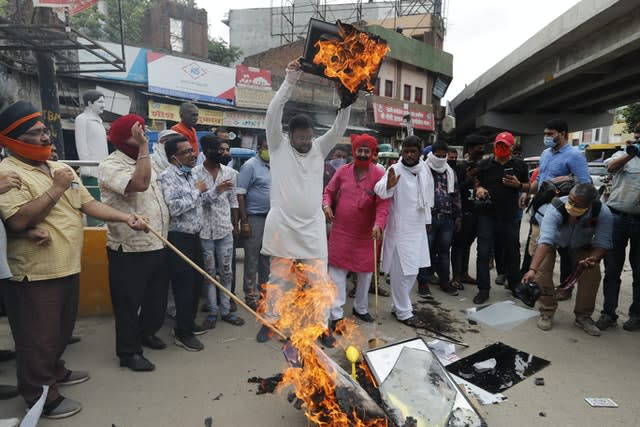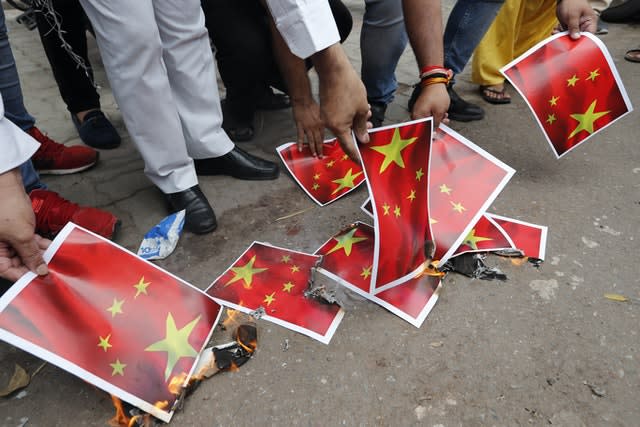China tells India to punish those behind deadly border clashes
China’s foreign minister has demanded that India punish those behind recent deadly border clashes between their forces and is warning New Delhi not to underestimate China’s determination to safeguard what it considers its sovereign territory.
Wang Yi’s comments came in a telephone call with his Indian counterpart, Subrahmanyam Jaishankar, that came two days after soldiers from the sides engaged in fighting along their disputed border high in the Himalayan Mountains.
Twenty Indian troops were reportedly killed and China suffered an unknown number of casualties.
Mr Wang said China demanded India conduct a thorough investigation and “harshly punish” those responsible.
“The Indian side would best not make an incorrect judgement of the situation, would best not underestimate China’s strong determination to safety its sovereign territory,” he said in a statement issued by the foreign ministry.

Mr Wang repeated China’s claims that India was solely responsible for the conflict, saying its forces had on three occasions “illegally” crossed the Line of Actual Control that divides the thousands of troops from the sides deployed in the area.
The statement said Mr Jaishankar explained India’s position, but gave no details, and said New Delhi was committed to talks on reducing tensions.
Earlier, China said it was seeking a a peaceful resolution to the dispute.
“Both sides agree to resolve this matter through dialogue and consultation and make efforts to ease the situation and safeguard peace and tranquillity in the border area,” Chinese Foreign Ministry spokesperson Zhao Lijian said at a daily briefing.
Indian security forces said neither side fired any shots in the clash in the Ladakh region late on Monday that was the first deadly confrontation on the disputed border between India and China since 1975.
Some officials said the soldiers were carrying anti-riot gear instead of weapons.
China has not said if any of its troops were injured or killed.
India’s prime minister Narendra Modi said the country would be proud that the Indian soldiers died while fighting.
“Their sacrifices wouldn’t go to waste. For us, the unity and sovereignty of the country is the most important. India wants peace but when provoked, it is capable of giving a fitting reply be it any kind of situation,” he said.
India’s defence minister Rajnath Singh tweeted that the loss of soldiers in the Galwan Valley is “deeply disturbing and painful”.
A group of protesters gathered near the Chinese Embassy in the Indian capital condemning the killing of the soldiers and demanding a ban on Chinese goods.

They carried placards with crossed photographs of Chinese President Xi Jinping and the Chinese army.
A small group of retired Indian army personnel also marched close to the embassy with placards reading “Chinese army down down”.
They were detained by police.
Mr Zhao, the Chinese spokesperson, repeated Chinese claims that the clashes erupted after Indian forces “provoked and attacked Chinese personnel, which lead to fears, physical confrontation between the two sides’ border troops and resulted in casualties.”
China claims about 35,000 square miles of territory in India’s northeast, while India says China occupies 15,000 square miles of its territory in the Aksai Chin Plateau in the Himalayas, a contiguous part of the Ladakh region.
India unilaterally declared Ladakh a federal territory while separating it from disputed Kashmir in August 2019.
China was among the handful of countries to strongly condemn the move, raising it at international forums including the UN Security Council.
Thousands of soldiers on both sides have faced off over a month along a remote stretch of the 2,100-mile Line of Actual Control, the border established following a war between India and China in 1962 that resulted in an uneasy truce.

The tense standoff started in early May, when Indian officials said that Chinese soldiers crossed the boundary at three different points, erecting tents and guard posts and ignoring verbal warnings to leave.
That triggered shouting matches, stone-throwing and fistfights, much of it replayed on television news channels and social media.
The Indian army said three soldiers died initially in Monday’s clash.
The 17 others died after being “critically injured in the line of duty and exposed to sub-zero temperatures in the high-altitude terrain”, it said in a statement Tuesday that did not disclose the nature of the soldiers’ injuries.
The troops fought each other with fists and rocks, Indian security officials said.
After the clash, the two sides “disengaged” from the area where the the fighting happened, the Indian army statement said.
The United Nations urged both sides “to exercise maximum restraint.”

